AMD Teases FSR 3 and Hypr-RX: Updated Radeon Performance Technologies Available in September
by Ryan Smith on August 25, 2023 11:31 AM EST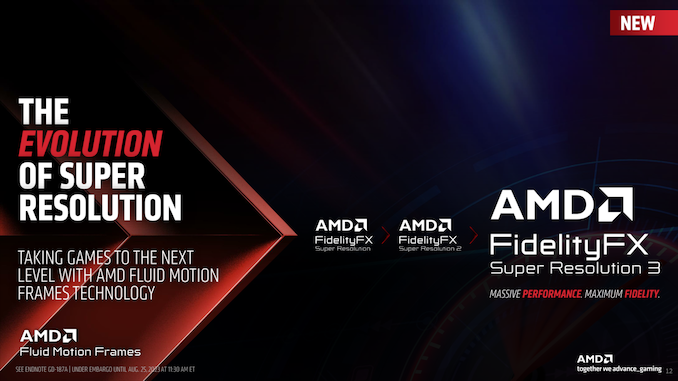
Alongside this morning’s announcement of the new Radeon RX 7800 XT and RX 7700 XT video cards, AMD is also using their Gamescom launch event to deliver an update on the state of their Radeon software stack. The company has been working on a couple of performance-improvement projects since the launch of the Radeon RX 7000 series in late 2022, including the highly anticipated FSR 3, and they’re finally offering a brief update on those projects ahead of their September launches.
FSR 3 Update: First Two Games Available in September
First and foremost, AMD is offering a bit of a teaser update on Fidelity FX Super Resolution 3 (FSR 3), their frame interpolation (frame generation) technology that is the company’s answer to NVIDIA’s DLSS 3 frame generation feature. First announced back at the Radeon RX 7900 series launch in 2022, at the time AMD only offered the broadest of details on the technology, with the unspoken implication being that they had only recently started development.
At a high level, FSR 3 was (or rather, will be) AMD’s open source take on frame interpolation, similar to FSR 2 and the rest of the Fidelity FX suite of game effects. With FSR 3, AMD is putting together a portable frame interpolation technique that they’re dubbing “AMD Fluid Motion Frames” and, unlike DLSS, is not vendor proprietary and can work on a variety of cards from multiple vendors. Furthermore, the source code for FSR3 will be freely available as part of AMD’s GPUOpen community.
Since that initial announcement, AMD has not had anything else of substance to say on the state of FSR 3 development. But at last, the first shipping version of FSR 3 is in sight, with AMD expecting to bring it to the first two games next month.
Ahead of that launch, they are offering a small taste of what’s to come, with some benchmark numbers for the technology in action on Forspoken. Using a combination of Fluid Motion Frames, Anti-Lag+, and temporal image upscaling, AMD was able to boost 4K performance on Forspoken from 36fps to 122fps.
Notably, AMD is using “Performance” mode here, which for temporal upscaling means rendering at one-quarter the desired resolution of a game – in this case, rendering at 1080p for a 4K/2160p output. So a good deal of the heavy lifting is being done by temporal upscaling, but not all of it.
AMD has also published a set of numbers without temporal upscaling, using their new native anti-aliasing mode, which renders at the desired output resolution and then uses temporal techniques for AA, and combines that with Fluid Motion Frames. In that case, performance at 1440p goes from 64fps to 106fps.
For the time being, these are the only two sets of data points AMD is providing. Otherwise, the screenshots included in their press deck are not nearly high enough in quality to make any kind of meaningful image quality comparisons, and AMD hasn’t published any videos of the technology in action. So convincing visual evidence of FSR 3 in action is, at least ahead of today’s big reveal, lacking. But it is a start none the less.
As for the technical underpinnings, AMD has answered a few questions relating to FSR3/Fluid Motion Frames, but the company is not doing a deep dive on the technology at this time. So there remains a litany of unanswered questions about its implementation.
With regards to compatibility, according to AMD FSR3 will work on any RDNA (1) architecture GPU or newer, or equivalent hardware. RDNA (1) is a DirectX Feature Level 12_1 architecture, which means equivalent hardware spans a pretty wide gamut of hardware, potentially going back as far as NVIDIA’s Maxwell 2 (GTX 900) architecture. That said, I suspect there’s more to compatibility than just DirectX feature levels, but AMD isn’t saying much more about system requirements. What they are saying, at least, is that while it will work on RDNA (1) architecture GPUs, they recommend RDNA 2/RDNA 3 products for the best performance.
Along with targeting a wide range of PC video cards, AMD is also explicitly noting that they’re targeting game consoles as well. So in the future, game developers will be able to integrate FSR3 and have it interpolate frames on the PlayStation 5 and Xbox Series X|S consoles, both of which are based on AMD RDNA 2 architecture GPUs.
Underpinning FSR 3’s operation, in our briefing AMD made it clear that it would require motion vectors, similar to FSR 2’s temporal upscaling, as well as rival NVIDIA’s DLSS 3 interpolation. The use of motion vectors is a big part of why FSR 3 requires per-game integration – and a big part of delivering high quality interpolated frames. Throughout our call “optical flow” did not come up, but, frankly, it’s hard to envision AMD not making use of optical flow fields as well as part of their implementation. In which case they may be relying on D3D12 motion estimation as a generic baseline implementation, since it wouldn’t require accessing each vendor’s proprietary integrated optical flow engine.
What’s not necessary, however, is AI/machine learning hardware. Since AMD is targeting the consoles, they wouldn’t be able to rely on it anyhow.
AMD also says that FSR 3 includes further latency reduction technologies (which are needed to hide the latency of interpolation). It’s unclear if this is something equivalent to NVIDIA’s Reflex marker system, or if it’s something else entirely.
The first two games to get FSR 3 support will be the aforementioned Forspoken, as well as the recently launched Immortals of Aveum. AMD expects FSR 3 to be patched in to both games here in September – presumably towards the later part of the month.
Looking farther forward, AMD has lined up several other developers and games to support the technology, including RPG-turned-technology-showcase Cyperpunk 2077. Given that Forspoken and Immortals of Aveum are essentially going to be the prototypes for testing FSR 3, AMD isn’t saying when support for the technology will come to these other games. Though with plans to make it available soon as an Unreal Engine plugin, the company certainly has its eyes on enabling wide-scale deployment of the technology over time.
For now, this is only a brief teaser of details. I expect that AMD will have a lot more to say about FSR 3, and to disclose, once the FSR 3 patches for Forspoken and Immortals of Aveum are ready to be released.
Hypr-RX: Launching September 6th
Second up, we have Hypr-RX. AMD’s smorgasbord feature combines the company’s Radeon Super Resolution (spatial upscaling), Radeon Anti-Lag+ (frame queue management), and Radeon Boost (dynamic resolution scaling). All three technologies are already available in AMD’s drivers today, however they can’t all currently be used together. Super Resolution and Boost both touch the rendering resolution of a game, and Anti-Lag steps on the toes of Boost’s dynamic resolution adjustments.
Hypr-RX, in turn, is designed to bring all three technologies together to make them compatible with one another, and to put the collective set of features behind a single toggle. In short, if you turn on Hypr-RX, AMD’s drivers will use all of the tricks available to improve game performance.
Hypr-RX was supposed to launch by the end of the first half of the year, a date that has since come and gone. But, although a few months late, AMD has finally finished pulling together the feature, just in time for the Radeon RX 7800 XT launch.
To that end, AMD will be shipping Hypr-RX in their next Radeon driver update, which is due on September 6th. This will be the launch driver set posted for the RX 7800 XT, bringing support for the new card and AMD’s newest software features all at once. On that note, it bears mentioning that Hypr-RX requires an RDNA 3 GPU, meaning it’s only available for Radeon RX 7000 video cards as well as the Ryzen Mobile 7040HS CPU family.
Taking a quick look at performance, AMD has released some benchmark numbers showing both the latency and frame rates for several games on the RX 7800 XT. In all cases latency is down and framerates are up, varying on a game-by-game basis. As these individual technologies are already available today, there’s not much new to say about them, but given the overlap in their abilities and the resulting technical hurdles, it’s good to see that AMD finally has them playing nicely together.
But with FSR 3 and its frame interpolation abilities soon to become available, AMD won’t be stopping there for Hypr-RX. The next item on AMD’s to-do list is to add Fluid Motion Frame support to Hypr-RX, allowing AMD’s drivers to use frame interpolation (frame generation) to further improve game performance.
This is a bigger and more interesting challenge than it may first appear, because AMD is essentially promising to (try to) bring frame interpolation to every game on a driver level. FSR 3 requires that the technology be built in to each individual game, in part because it relies on motion vector data. That motion vector data is not available to driver-level overrides, which is why Hypr-RX’s Radeon Super Resolution ability is only a spatial upscaling technology.
Put another way: AMD apparently thinks they can do frame interpolation without motion vectors, and still achieve a good enough degree of image quality. It’s a rather audacious goal, and it will be interesting to see how it turns out in the future.
Wrapping things up, AMD’s current implementation of Hypr-RX will be available on September 6th as part of their new driver package. Meanwhile Hypr-RX with frame interpolation is a work in progress, and will be coming at a later date.


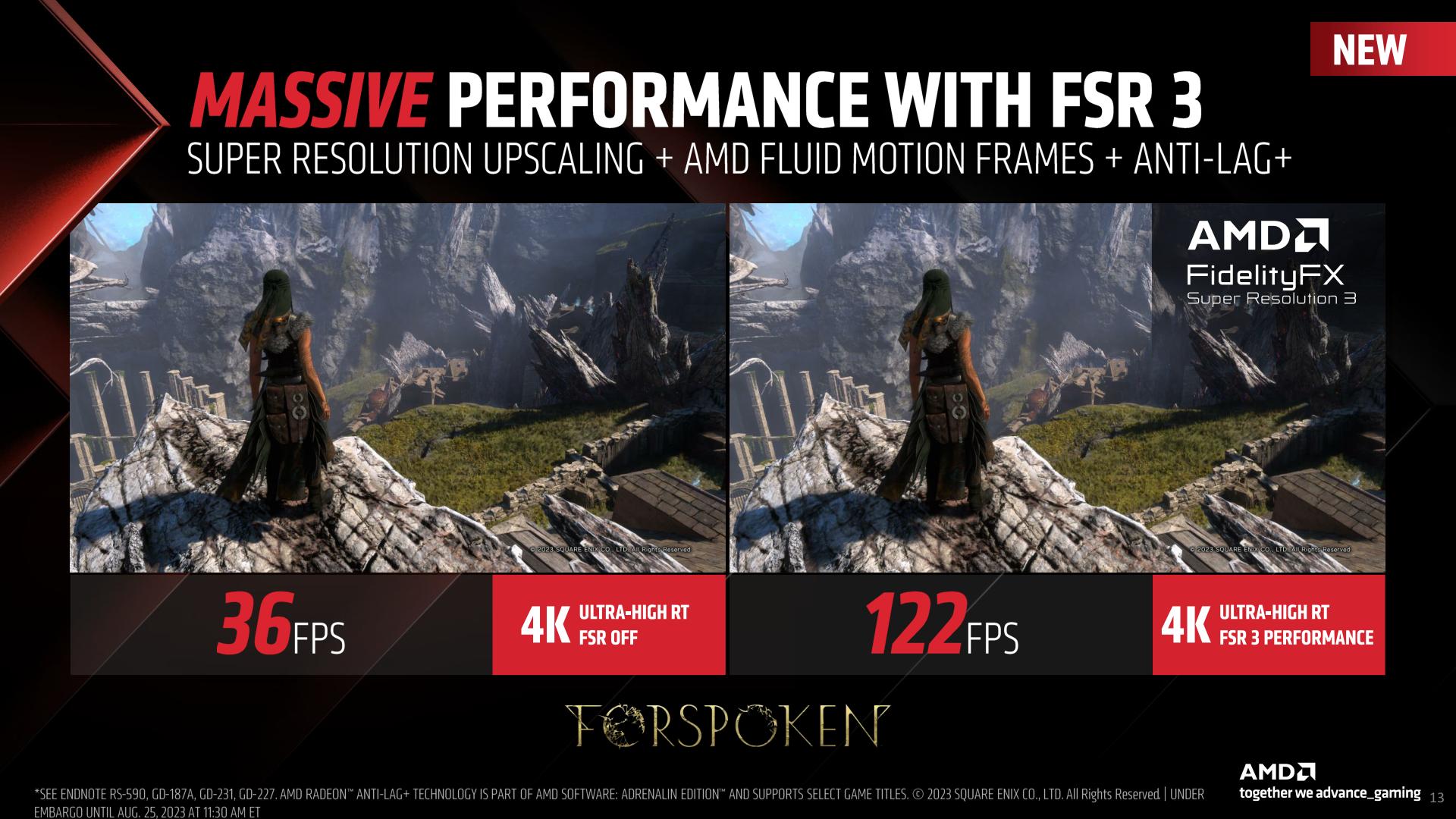
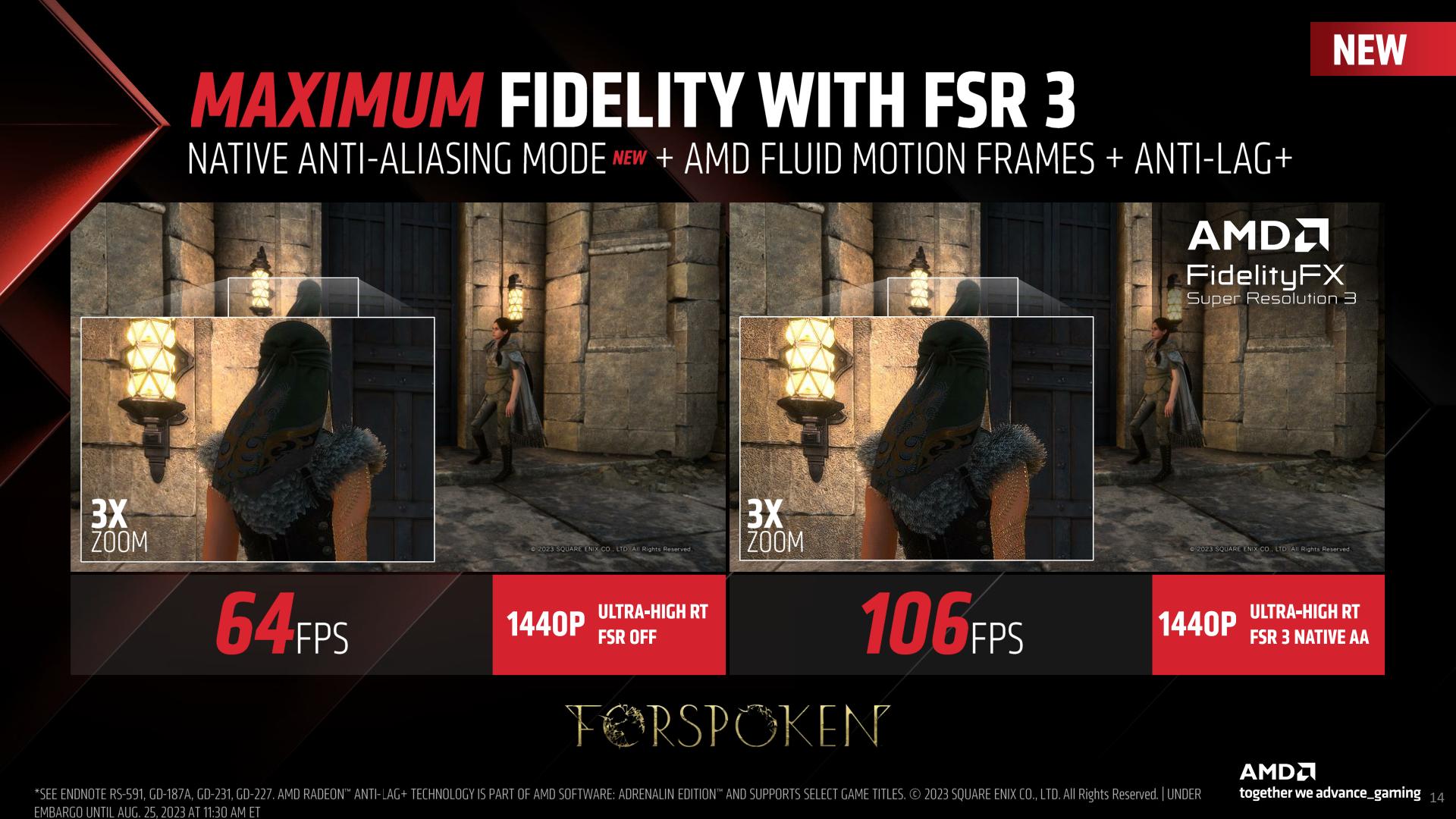

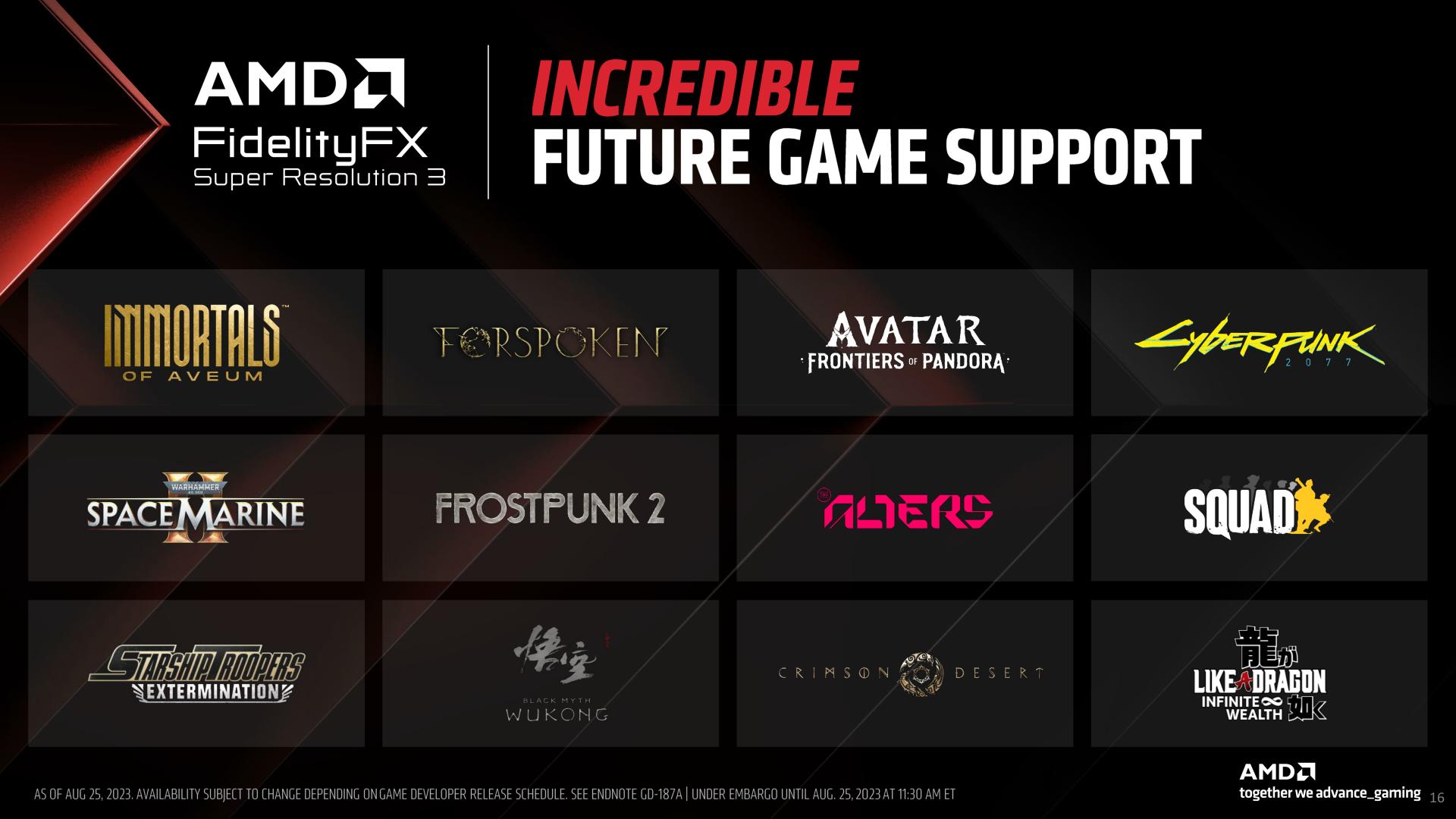
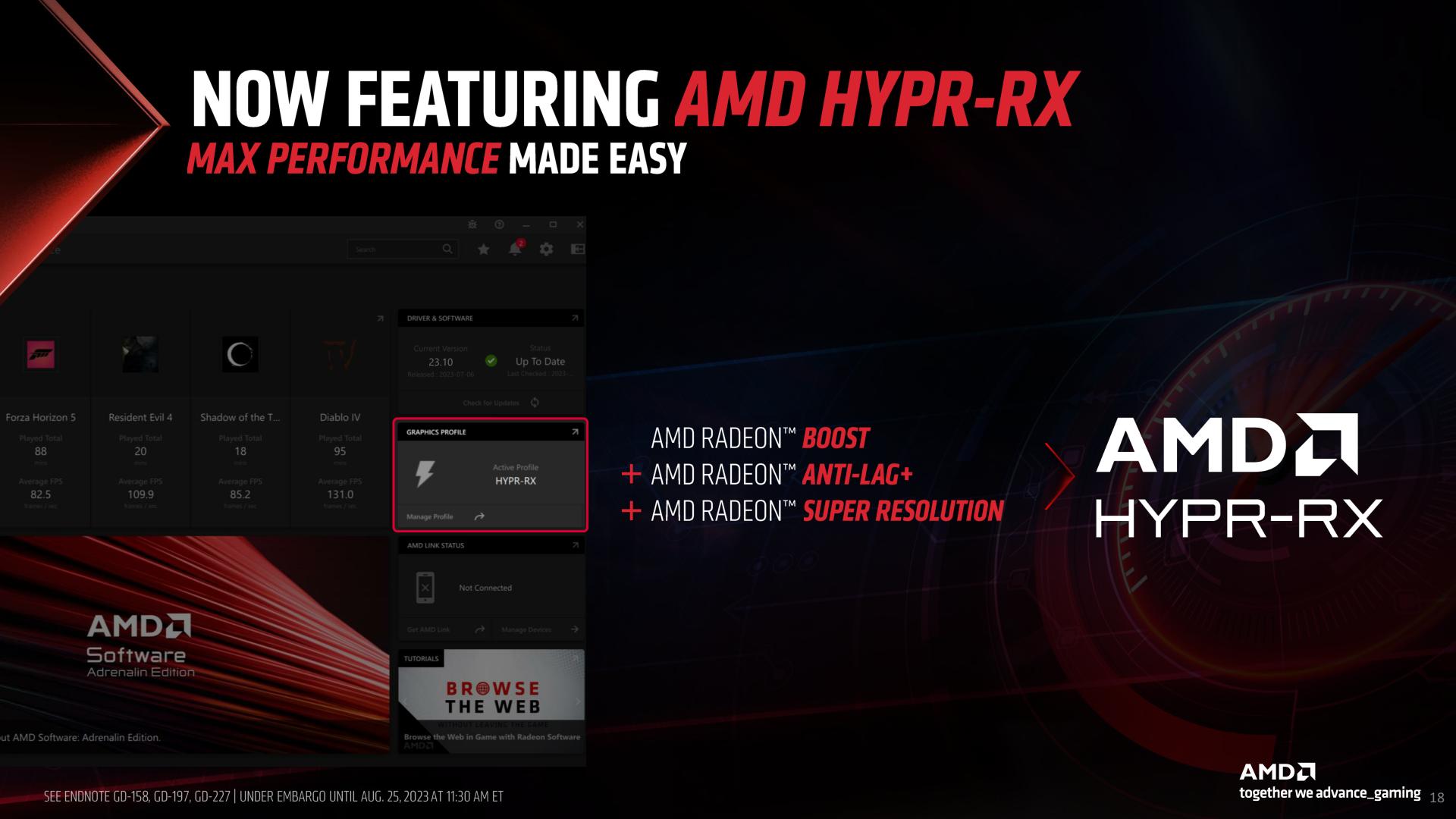
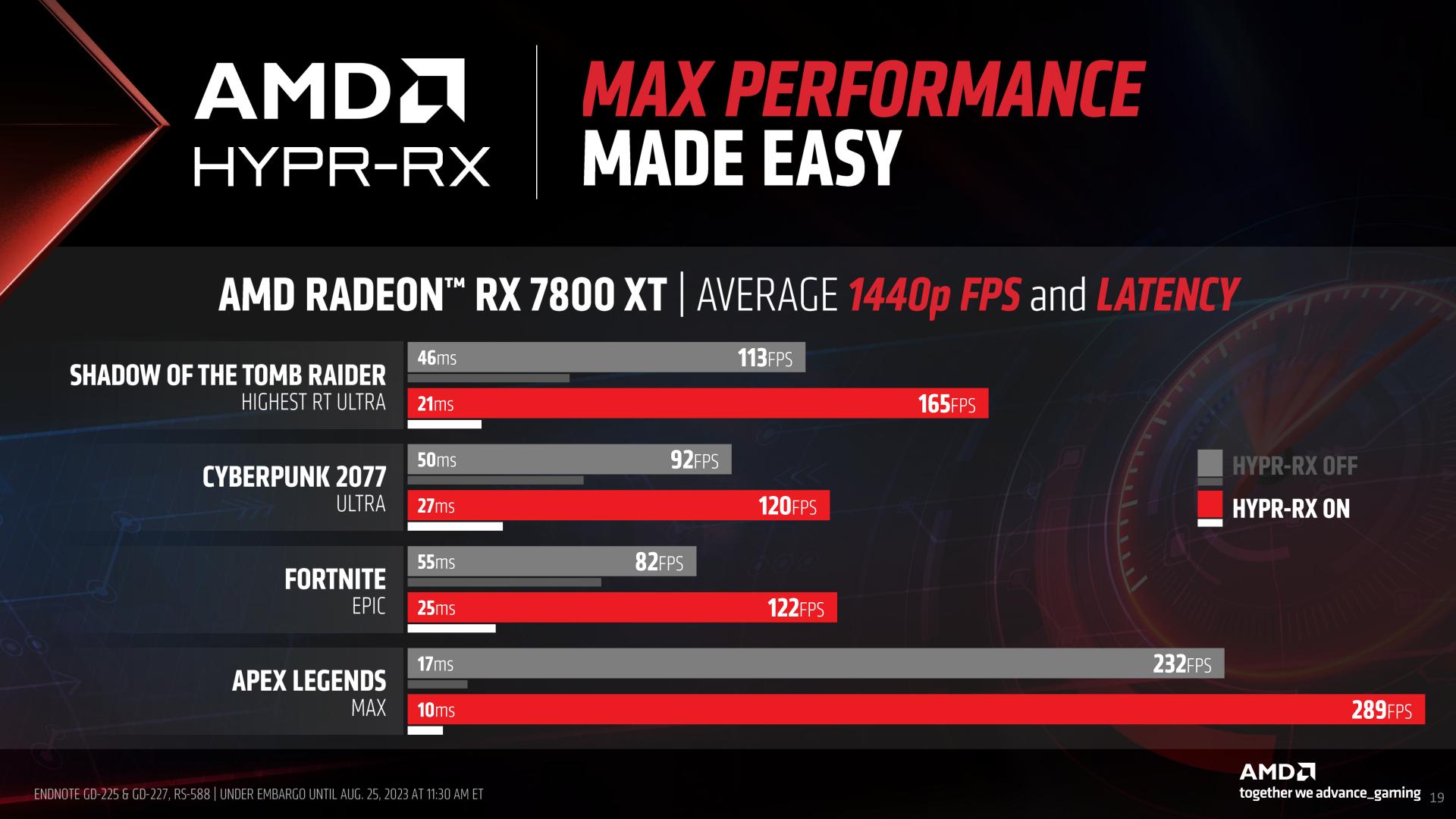









43 Comments
View All Comments
nandnandnand - Saturday, August 26, 2023 - link
3060's 12 GB of VRAM was an anomaly in the broken Ampere lineup (more than the 3080 with 10 GB), and it's a popular choice for babby's first AI GPU. The 4060 is still faster than the 3060 at 1080p/1440p, even if the 8 GB of VRAM isn't going to age very well or already falls flat in some games.Qasar - Sunday, August 27, 2023 - link
" DLSS isn't a crutch" go look at reviews of the 4060 vs the 3060. with out DLSS the 4060 is slower. the reality is, the 4060, really should be labeled as a 4050. nvidia castrated the cards way too much vs previous gen. the 3060 even has a faster memory bus then the 4060Yojimbo - Tuesday, August 29, 2023 - link
What does the market position of the 4060 have to do with DLSS? Both the 30 series and the 40 series of cards are pursuing the same resource paradigm, anyway. You need to compare it with a card, real or hypothetical, that is pursuing a paradigm of purely traditional rasterization.The way a comparison should be made is with resources to produce the card versus quality of output, which include image quality and performance. Power is also a relevant factor but I'm pretty sure that would come down on the side of the DLSS/ray tracing paradigm, and, anyway, the image quality differences would be so great that it would be like comparing apples to oranges, power-wise.
As far as the 4060, it's not a direct replacement for the 3060. It's far cheaper, adjusted for inflation (CPI-adjusted price of the Feb 2021 $329 3060 would be $380 now. The 4060 was released at $299), and it uses far less power. Nvidia's product stack was compressed in the Turing generation (20 series), and since then they have been stretching it back out. The 16 series was a one-off dead end because Nvidia could not cover the entire stack with the new paradigm in the first generation. So the 2060 was actually a large and power hungry (440 mm^2 and 160 W) compared to the 1060 (200 mm^2 and 120 W). The difference in size is somewhat inflated by the fact that they are on the same-generation process technology (16 nm vs 12 nm) and cost per transistor had gone down in the ensuing 2 years, but even adjusted for that, the 2060 is a much larger chip. The 4060 is now back down to 146 mm^2 and 115 W. For comparison, the 3060 is 276 mm^2 and 170 W, so you can see the trend of reduced die area and/or power after the jump from the 1060 to the 2060 down to the 4060. The $249 price of the 1060 at launch in 2016 is an inflation-adjusted $316 today, whereas the 4060 has launched for $299. In fact the die size suggests that the 4060 occupies a position in the stack akin to somewhere between a 1050 Ti and a 1060, but is slightly more expensive. All the narratives about the 4060 and 4060 Ti being bad values and out of line with prior generations are the result of flawed analysis.
Nvidia is likely done re-stretching their product stack now. Also, although inflation is likely to remain higher over the next 2 years than it was prior to 2021, the big hump of inflation is past us. When the 50 series comes out these hardware sites will be celebrating the miraculous return to gen on gen value increases, probably attributing it to competition with Intel, or something, when in fact it will be pretty much in line with previous generational changes including the change from the 30 series to the 40 series.
Kurosaki - Tuesday, August 29, 2023 - link
DLSS is just a way to run games in 1080p but say you can run it in 4k. It's a sham.Dante Verizon - Friday, August 25, 2023 - link
The advancement in graphics is precarious compared to the requirements, I only see signs of poorly optimized games tbhYojimbo - Saturday, August 26, 2023 - link
advancement naturally slows down as the technology matures. it's been slowing ever since the beginning. The compute and memory bandwidth improvement per year is getting smaller and smaller, the easy algorithms for raster tricks were found years ago, and it's getting harder and harder to apply the increase in compute resource that do occur to significantly improve image quality. That's why technologies like ray tracing, upscaling, and frame generation are important to squeeze out image quality improvements more efficiently.Zoolook - Saturday, August 26, 2023 - link
You are mistaking erroneous frames being created faster for increased quality, when you are actually sacrificing quality for improved framerates, that to visually challenged people can appear to look good.In reality the number of artifacts per frame is rising quickly.
Yojimbo - Saturday, August 26, 2023 - link
All computer graphics consist of erroneous frames. Rasterized graphics consist of grossly erroneous frames. There's no purity in your "real pixels". "Real pixels" aren't real. What matters is what the brain perceives. You don't call black frame insertion "erroneous frames", do you? Motion video itself is a trick. You are missing over 99% of the data, have you ever thought about that? You get one still image and then a jump to another still image some time later that is related spatially and temporally and your brain interpolates what must have happened in between. It's not real. A computer can also interpolate what happens in between. It's not worse than your mind in doing so, but it helps your mind along with the process. Your brain just needs to understand what is happening with the underlying motion these frames are trying to approximate. The generated frames help with that just as the calculated frames do. Looking at a still frame of a generated frame and seeing artifacts means nothing. If you rarely see the artifacts in full motion yet the image is less blurry and smoother then you have increased the image quality because you have created a more accurate and more comfortable perception for the brain.CiccioB - Tuesday, August 29, 2023 - link
No.You are mistaking resolution for absolute image quality.
Image quality is not only about resolution, as most gamers think. "I play at 4K, so I have the best image quality possible".
Actually, image quality depends mostly on many other things, like texture quality, polygons density, lights quality (and their representation). Moreover you have to take care also of the frame rate, as a super realistic still image doesn't allow you to play to anything even it is the best thing your eyes have ever seen.
Having limited resources, you have to compromise between all those features to get a good enough image.
Now, if you take from the equation scalers and taking for granted you need a fast enough generation for smoothness, you end in having to make heavy compromises with everything, especially light rendering, to get an image at good native resolution and FPS.
If you instead can increase rendering quality at a lower resolution and have it scaled, you can end up with a better image quality you could have without scaling.
Of course it is still a compromise, as the more you scale the worse it will look nonetheless.
And that's why Nvidia DLSS is better than FSR from the quality point of view: because using inference, DLSS has to scale the image less (that is preserving more details) than what FSR needs to get the same compromises.
Now, everyone would like to have small 4090s at $300 capable of implementing all the new features that go beyond the now outdated raster tricks to render images at certain frequencies. Going beyond raster tricks allows engines to go beyond 2006 image quality with big flat surfaces, repeated geometric models and boring illumination. Unfortunately desire is not reality, and to reach some performances with new modern techniques, a big quantity of silicon is needed. Thus the fact that in 2023 still exists a difference between low level tier GPU and enthusiasts ones and we do not have all 4090 class GPUs in our hands for few bucks.
If you don't like 4060, you are not obliged to buy it. Find a better board for the same money. But be sure that better is really better, and not because you have decided that using flat surfaces and boring illumination is better than using a full featured rendering just a little scaled (all using less energy).
Dante Verizon - Tuesday, August 29, 2023 - link
Sorry, but RT is the least efficient way possible in terms of spending transistors vs return on performance. I would rather have 30% more shaders and raw rasterization power than RT at 30fps.